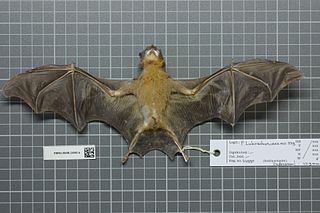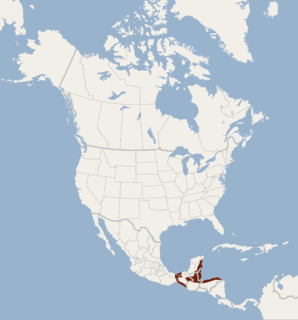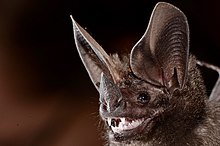
The spectral bat, also called the great false vampire bat or Linnaeus's false vampire bat, is a large, carnivorous leaf-nosed bat found in Mexico, Central America, and South America. It is the only member of the genus Vampyrum; its closest living relative is the big-eared woolly bat. It is the largest bat species in the New World, as well as the largest carnivorous bat: its wingspan is 0.7–1.0 m (2.3–3.3 ft). It has a robust skull and teeth, with which it delivers a powerful bite to kill its prey. Birds are frequent prey items, though it may also consume rodents, insects, and other bats.

The hairy-legged vampire bat is one of three extant species of vampire bats. It mainly feeds on the blood of wild birds, but can also feed both on domestic birds and humans. This vampire bat lives mainly in tropical and subtropical forestlands of South America, Central America, and southern Mexico. It is the sole member of the genus Diphylla.

The black mastiff bat is a bat species. It ranges from the northern region of South America, most of Central America and parts of southern Mexico.

The broad-eared bat, or broad-tailed bat, is a species of free-tailed bat from the Americas.

The tricolored big-eared bat is a bat species from South and Central America.

The yellow-throated big-eared bat or orange-throated bat(Lampronycteris brachyotis) is a species of bat from South and Central America, where it ranges from southern Mexico to Brazil. It is monotypic within the genus Lampronycteris. A frugivore and insectivore, it is found in lowland forest up to an elevation of 700 m. Its activity is greatest in the first two hours after sunset, and peaks again after midnight.

Tomes's sword-nosed bat, also known as the common sword-nosed bat is a bat species from South and Central America. It is also found in the Bahamas, as is known only from one specimen collected on the island of New Providence.

Carriker's round-eared bat is a bat species from South America. It is found in Bolivia, Brazil, Colombia, Guyana, Peru, Suriname and Venezuela. It was discovered by and named for Melbourne A. Carriker, Jr.

The white-throated round-eared bat is a South and Central American bat species found from Honduras to Bolivia, Paraguay and Brazil. It creates roosts inside the nests of the termite, Nasutitermes corniger. It thrives on a mainly insect-based diet, focusing on the surfaces of foliage to hunt, and also eats fruit and pollen. It has a very wide range and is a common species over much of that range, so the International Union for Conservation of Nature has assessed its conservation status as being of "least concern".

The common big-eared bat is a bat species from South and Central America. It is a neotropical leaf-nosed bat.

Schmidts's big-eared bat is a bat species from South and Central America.

Niceforo's big-eared bat is a bat species from South and Central America, ranging from Chiapas to Bolivia and northeastern Brazil. Its habitat is primary and secondary forest at altitudes from sea level to 1000 m. It is crepuscular, being most active in the hour after sunset and before dawn. The species is monotypic within its genus.

Lophostoma is a genus of Central and South American bats in the family Phyllostomidae.

The velvety fruit-eating bat, also known as Hart's little fruit bat, is a species of bat in the family Phyllostomidae. It is monotypic within the genus Enchisthenes. It is found in Central America, Mexico, the United States, and northern South America.

Davis's round-eared bat is a species of Central American bat in the family Phyllostomidae. It is found in Belize, Guatemala, Honduras, and southeastern Mexico.

The Thomas's shaggy bat is a bat species from South America. It was previously included in the shaggy bat but Simmons and Handley (1998) showed that the species were distinct.

The Cozumelan golden bat is a bat species from Central and northern South America. It is found in Mexico, Guatemala, Belize, Honduras, Nicaragua, Costa Rica, Panama and Colombia. At one time this species was considered to be a subspecies of the golden bat. Little is known about the biology of this bat but it has a wide range, no particular threats have been identified and the population seems steady, so the International Union for Conservation of Nature has assessed its conservation status as being of "least concern".

The western round-eared bat is a bat species found only on the Pacific coast of northwestern Ecuador.

Eumops nanus is a species of bat found in Central and South America.
The Chocoan long-tongued bat is a species of bat found in South America. It was described as a new species in 2004.





















